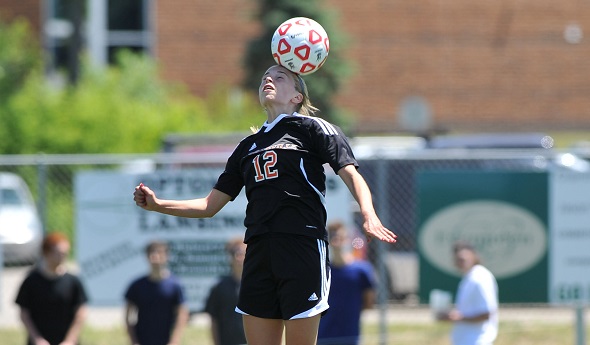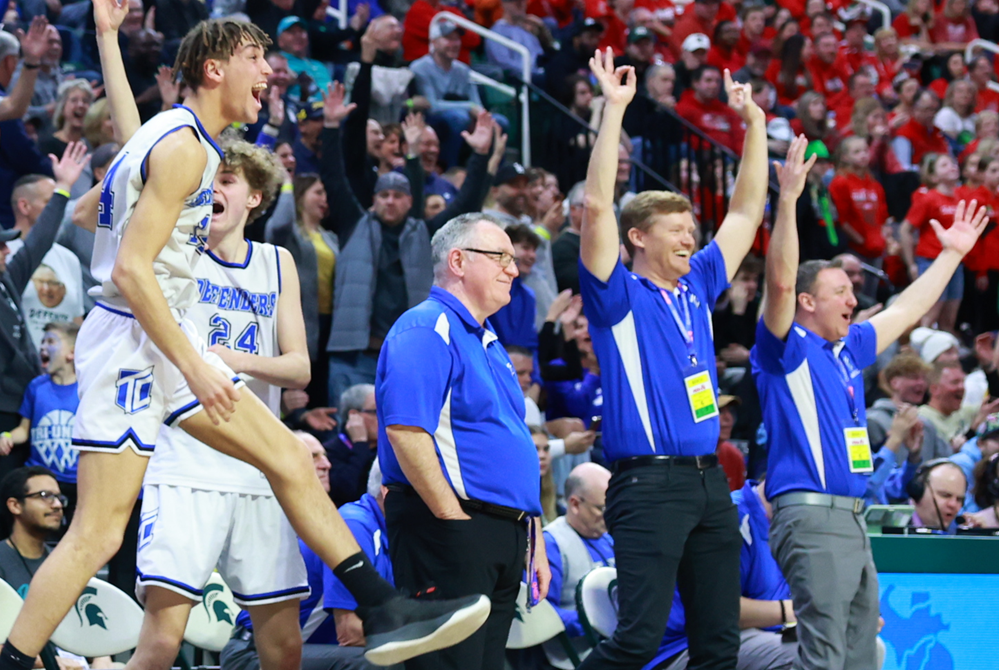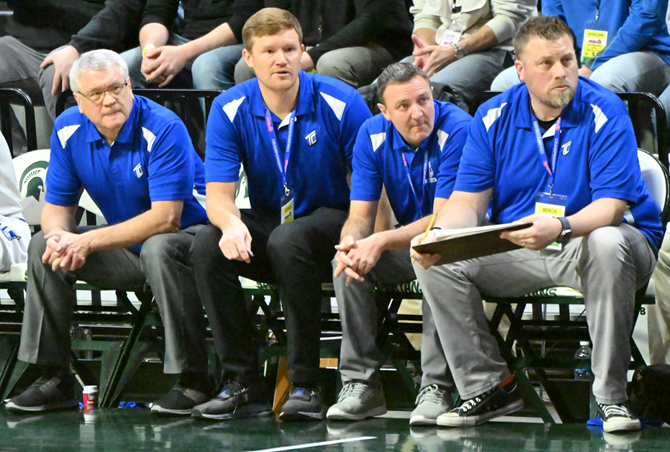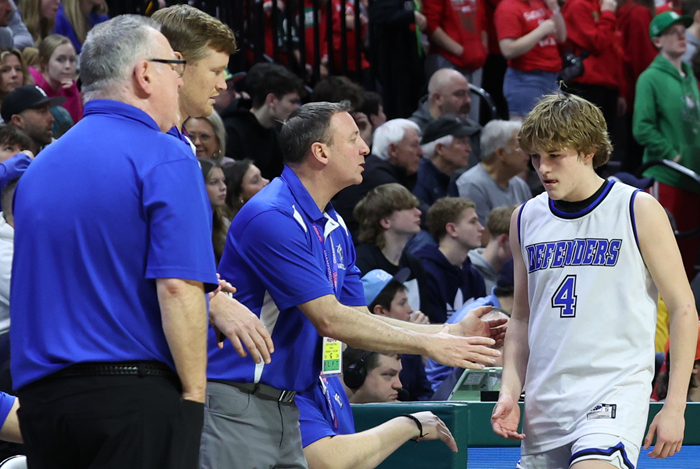
Staying Ahead on Head Safety
July 6, 2015
By Rob Kaminski
MHSAA benchmarks editor
Three stacks of concussion-related material offered precious little space on MHSAA Executive Director Jack Roberts’ desk, and perhaps consumed even more room in his head as he tried to wrap his mind around the seemingly daily “latest and greatest” documents outlining signs, detection and return-to-play elements involving head trauma.
Without a doubt, the scene is quite similar on any given day in the offices of his cohorts across the country as school sports leaders are faced with the daunting, dizzying task of devising plans to address concerns aimed at the health of their games.
Lawmakers, rules makers, medical experts and the court of public opinion all want the same thing for student-athletes: a reduction in the chances of head-related injuries. And they all are perfectly willing to offer instant fixes to those in charge.
They often expect those in Roberts’ position to analyze, digest and create action plans as soon as possible without considering the research and resources it will take to get there.
“All parties involved want the same thing. We all want to provide the safest environment for educational athletics through protocols and practices that will offer the most minimal risk of injury,” Roberts said. “But, this can’t be accomplished through unfunded mandates which would stifle the already struggling athletic budgets in many schools.
“Changes have to occur through training and education, orchestrated through state offices and executed locally. And, it takes time to research the best and most effective means. There is so much information, and so many devices in the field today that those in athletic leadership roles almost have to have a medical background as well.”
For instance, there are documents which list as few as five symptoms for concussions, and those listing as many as 15. There are sideline detection methods which purport to take 20 minutes and those which claim to determine concussions in 20 seconds. There are as many return-to-play protocols as there are state associations.
Increasingly, state high school associations are seeking opinions and expertise from local medical personnel. In March, in one of many such meetings, Roberts and other MHSAA staff welcomed several from the Michigan Department of Health and Human Services to their office to discuss sideline detection methods and return-to-play issues.
“There are two areas that concerned us most,” Roberts said. “One, sideline detection of head injuries is inconsistent across the state in terms of both results and resources. Two, we need methods which generate immediate reports and permanent records.”
As the group which convened in March discussed the topic, potential hurdles and new perspectives on sideline management came to the forefront.
On the money and manpower front, who would be responsible for administering sideline tools? Most ideally they would need to be overseen by medical personnel rather than coaches or team managers.
From a perspective standpoint, an interesting view was volleyed out to the group: could sideline detection actually speed up a student’s return to play rather than slow it down? Current protocol prescribes that if competition continues while an athlete is withheld for an apparent concussion, that athlete may not be returned to competition that day but is subject to the return-to-play protocol. And, clearance may not be on the same date on which the athlete was removed from play. Only an M.D., D.O., Physician’s Assistant or Nurse Practitioner may clear the individual to return to activity. With immediate sideline detection, are parties more vulnerable should a student pass immediate tests, only to have undetected effects of the incident increase over time?
“The group shed a different light on the various scenarios, which was a primary purpose for the meeting,” Roberts said. “As one can see, there are so many variables to consider when attempting to determine the next plausible and practical steps toward minimizing and detecting head injuries.
“Further, we have to take into consideration practice sessions as well as competitions, and all sports, not just select sports.”
Adding to the challenge is simply the nature of athletics. Competitors at any level are just that: competitive. Often, students – or their parents – will attempt to hide symptoms or be reluctant to come forward with injuries, particularly head injuries which can’t be seen.
In more cases, perhaps the symptoms simply are not recognized, which is why education is paramount.
First, association leaders have to tackle the due diligence of researching issues and potential solutions to situations currently threatening the well-being of scholastic sports. Considering that some 1,620,000 results are offered when “sideline concussion detection tools” is typed into a search engine, this is a laborious and continual chore.
Such information then needs to be packaged and presented to leaders at the local levels – athletic directors – to pass on to coaches, the individuals who have as much or more influence on students that perhaps any other adults, including parents in some cases.
This is why MHSAA rules meetings, Coaches Advancement Program sessions and other statewide forums continue to bang the drum on health and safety issues; to make sure the messages and procedures reach the student-athletes.
And, it’s why the MHSAA is asking coaches and ADs to be accountable in verifying that the plans in place are being carried out.
Less Could Mean Less
There are times when it’s good to say, “less means more,” but in the case of contact sports, practices and competitions, the idea is for less to mean less. As in less time for collisions to occur yielding fewer injures.
It’s early yet, and one year does not constitute a large sample size, but the MHSAA Football Practice Policy instituted last August could be one step toward reducing head injuries.
Beginning this past football season, the number of practices with helmets, shoulder pads and full pads were limited to start the season, and preseason “collision” sessions were limited to one per day. During the season, such practices were limited to two per week, while the length of practices was also regulated.
Dr. Steven Broglio of the University of Michigan Neurosport department is conducting a three-year study of the Ann Arbor Gabriel Richard football program with the assistance of Richelle Williams to determine the “Effects of Concussion and Sub-Concussion.” The study began in 2013, one year prior to the new MHSAA guidelines.
Research in 2013 showed approximately 650 “impacts” per player. In 2014, the number dropped to approximately 500 impacts per player. Impacts are defined as greater than 10 gs of acceleration. Williams stated that a slap on the back is 4 g, coughing is 3.5 g. On average, a helmet hit is 25-45 g. Concussions usually happen (roughly) between 80-150g.
An encoder is embedded into each football athlete’s helmet which monitors head impacts and exactly where the impact is located. Williams sits at each practice and game and through a pager identifies the player’s number and impact from a hit of 90g or more.
They are also looking at those who do not sustain an impact concussion, but rather sustain multiple head impacts and whether those multiple head impacts lead up to brain changes (measured through EEG).
The initial findings, as submitted by the study team, indicated two reasons why there were fewer overall impacts from 2013 to 2014:
Primary reason: The MHSAA adoption that became effective in August 2014 with new limitations that were placed on “collision practices” and conditions that full pads could not be worn until the fifth day of team practice.
Secondary reason: Fewer players evaluated in 2014 than 2013.
Fit for a King?
Editor’s Note: There are many sideline detection tools on the market, as a quick Google on the topic will reveal. The following, the King-Devick test, is among the highly recommended tests, summarized here simply to provide an idea of the types of systems available and how they operate. The following is from King-Devick’s website.
The King-Devick Test is an objective remove-from-play sideline concussion screening test that can be administered by parents and coaches in minutes. The King-Devick Test is an accurate and reliable method for identifying athletes with head trauma and has particular relevance to: Football, Hockey, Soccer, Basketball, Lacrosse, Rugby, Baseball, Softball and Other Collision Activities.
King-Devick Test is an easy-to-administer test which is given on the sidelines of sporting events to aid in the detection of concussions in athletes. King-Devick Test (K-D Test) can help to objectively determine whether players should be removed from games. As a result, King-Devick Test can help prevent the serious consequences of repetitive concussions resulting from an athlete returning to play after a head injury.
How King-Devick Test Works
Concussions are a complex type of brain injury that is not visible on routine scans of the brain, yet are detectable when important aspects of brain function are measured. King-Devick Test (K-D Test) is a two-minute test that requires an athlete to read single digit numbers displayed on cards or on an iPad. After suspected head trauma, the athlete is given the test and if the time needed to complete the test is any longer than the athlete’s baseline test time, the athlete should be removed from play and should be evaluated by a licensed professional.
Remove-From-Play vs. Return-To-Play
Both remove-from-play and return-to-play decisions are crucial in concussion recovery. It is critical to remove a concussed athlete from play in order to prevent further damage. It is also extremely important to keep the athlete from returning to play until they have made a full recovery. There are tools to assist in making both remove-from-play and return-to-play decisions.
King-Devick Test for Remove-From-Play Decisions
- Quick, objective sideline testing
- Measures impairments of speech, language and other correlates of suboptimal brain function
- Instant screening feedback in minutes
- Administered by parents, coaches, athletic trainers and medical professionals in remove-from-play decisions
- Neurocognitive Testing for Return-To-Play Decisions
- Computerized concussion evaluation system (in the computer lab)
- Measures verbal and visual memory, processing speed and reaction
- Tracks recovery of cognitive processes following concussion
- Assists clinicians in making return-to-play decisions

Championship Experience from Coach's Point of View Unimaginable, Unforgettable
By
Dean Holzwarth
Special for MHSAA.com
April 4, 2024
WYOMING – As the final buzzer sounded, it was all I could’ve imagined – and more.

In the weeks leading up to March 16 and the Division 4 championship game, I experienced every emotion possible as I envisioned what it would feel like to be an assistant coach on the bench at Michigan State’s Breslin Center as the Wyoming Tri-unity Christian boys basketball team achieved its ultimate goal.
In my first year as the junior varsity coach at Tri-unity, I had been on the varsity bench for a majority of the season, assisting legendary coach Mark Keeler and fellow assistants Brent Voorhees, Bob Przybysz and Mike Kaman.
I was there encouraging, motivating and supporting the varsity team. It was a role I embraced, and had become accustomed to over my almost 30 years coaching high school basketball.
I started coaching in 1995 as Jim Ringold gave me my first opportunity as the freshmen girls coach at Wyoming Kelloggsville High School. I would then coach Kelloggsville’s freshmen boys team for eight seasons, while also coaching the freshmen girls at Grandville High School. I would also coach the junior varsity teams at both schools.
I love coaching. I have a passion for it. I’ve always enjoyed getting the most out of my players while creating a bond between player and coach.
When girls basketball season moved from fall to winter joining the boys in 2007-08, I stayed at Grandville. I spent 21 seasons there before stepping down.
I still wanted to coach, and I heard that the Tri-unity junior varsity position was available. I had always respected and liked Keeler and was excited for the prospect of joining a perennial powerhouse.
I didn’t really know about Tri-unity growing up in the Wyoming Park school district. But as a young kid, I would rush home and eagerly await the afternoon delivery of the Grand Rapids Press. I would quickly find the sports page and read it from front to back, hoping one day to see my byline.
I began writing for the Press’ sports department in 1997. It was my dream job. And that’s also when I first started covering Tri-unity boys basketball.
I remember watching eventual NBA all-star Chris Kaman, along with Bryan Foltice and others play for this little Christian school and have unbridled success under Keeler.
MHSAA Tournament runs became the norm for the Defenders. They won their first Finals title in 1996, and they would claim four more over the next 26 years. They also had six runner-up finishes.
 I was sitting on media row writing for MHSAA.com in 2022 when Brady Titus led Tri-unity to its fifth state championship.
I was sitting on media row writing for MHSAA.com in 2022 when Brady Titus led Tri-unity to its fifth state championship.
I never thought that two years later I would be on the coaching staff as the Defenders pursued another one. But there I was.
I knew this year’s team had the potential to be special.
Tri-unity had returned four of its five starters from a year ago, after suffering a heart-breaking two-point loss to Munising in the Division 4 Final.
Eight seniors were on the roster. The team had a mix of talented guard play, senior leadership, size and depth. We had shooters and we played great defense, a trademark of Keeler’s teams.
This was the year, and that heaped lofty expectations on Keeler and the team. It was basically “state championship or bust.” Anything less would be considered a disappointment.
Keeler wanted it badly, and I knew the players did as well. I think they felt the pressure at times of living up to the expectations that had been set.
We had several lopsided wins, but also had a few tough losses to Division 2 and Division 3 teams – Grand Rapids Forest Hills Central, Wyoming Lee, Grandville Covenant Christian and Schoolcraft – all talented teams that I think made us better despite falling short.
As the postseason started, there was anxiety and excitement.
We were one of the favorites, but it wouldn’t be easy. We would have to earn each of the seven victories needed to win it all.
First came a District title, but then we had to play a quality Fowler team in its home gym in the Regional Semifinal. This was a game we knew would be a challenge – and it was.
We led by only one at halftime after a 7-0 run to end the second quarter. The score was tied 33-33 in the fourth quarter before senior Lincoln Eerdmans made a key 3-pointer to spark our victory.
As we went through the handshake line, several Fowler players said, “Good luck in the Finals.”
Our defense played extremely well in the Regional Final and state Quarterfinal to secure our team another trip to the Breslin.
St. Ignace was our opponent in the Semifinal, and we had to face a senior guard who could do it all – Jonny Ingalls. He lived up to the hype. He was good, and we didn’t have any answer for him in the first half. We trailed by one, only to fall behind by seven late in the third quarter.
Was this the end? Were we going to fall one game short of our goal?
 We were down by five points in the fourth quarter, but junior guard Keaton Blanker, and others, rose to the occasion. We rallied to win a tight one, and now we were one win away from a Division 4 title.
We were down by five points in the fourth quarter, but junior guard Keaton Blanker, and others, rose to the occasion. We rallied to win a tight one, and now we were one win away from a Division 4 title.
The night before the championship game, we stayed at a hotel in East Lansing as we had the first game of the day at 10 a.m. We had a team dinner, and the players seemed relaxed and eager to close out the season the way they had intended.
There was one thing that worried me. We were playing Mount Pleasant Sacred Heart. A team we had played in the second game of the season and defeated by 30 points.
Would we be overconfident? I had no idea. They were a different team now, but so were we. Anything could happen.
Keeler gave a spirited and emotional pregame speech. In last year’s loss to Munising, he felt like the team played not to lose, and this season his big thing was “I want to win.” He said it to every starter that Saturday morning during the final moments in the locker room before tipoff, asking all five individually to say it back – which they did, the first one quietly but followed by teammates replying louder and louder as everyone got fired up and “I want to win” rang through the locker room. I think it inspired all of us.
After a competitive first quarter, we started to find our rhythm and expanded the lead. We were ahead by double-digits at the half, and a state title was within our grasp. Senior Wesley Kaman buried a 3-pointer in the final seconds of the third quarter to give us a 20-point cushion. It was at that point I knew we were going to win.
All five starters reached double-figure scoring, led by Jordan VanKlompenberg with 19 points and Owen Rosendall with 14. That balance was intentional and a successful sign for our team all season.
The exhilaration of winning was intoxicating. I loved watching the boys celebrate something they had worked so hard to accomplish. I will never forget their faces. I looked to my right from my seat on the bench and watched them running onto the court, just wearing their joy. They were just elated.
I was so happy for Keeler, a devout Christian who is respected by so many people in high school basketball circles. I learned so much from him this season. The way he approaches each game, his competitiveness. He instills his strong faith in his players and understands that the game of basketball is a bridge to a higher purpose.
Keeler is the fourth-winningest coach in state boys basketball history with a record of 694-216, and will be the winningest active coach next winter as all-time leader Roy Johnston retired from Beaverton at the end of this season.
The tournament run was one of the best coaching experiences I have had, and I feel blessed to have had the opportunity to be a part of a state championship season.
 Dean Holzwarth has covered primarily high school sports for Grand Rapids-based WOOD-TV for five years after serving at the Grand Rapids Press and MLive for 16 years along with shorter stints at the Ionia Sentinel and WZZM. Contact him at [email protected] with story ideas for Allegan, Kent and Ottawa counties.
Dean Holzwarth has covered primarily high school sports for Grand Rapids-based WOOD-TV for five years after serving at the Grand Rapids Press and MLive for 16 years along with shorter stints at the Ionia Sentinel and WZZM. Contact him at [email protected] with story ideas for Allegan, Kent and Ottawa counties.
PHOTOS (Top) The Wyoming Tri-unity Christian bench, including the author (far right) and head coach Mark Keeler (middle), celebrate a 3-pointer late in the Defenders’ Division 4 championship win over Mount Pleasant Sacred Heart. (Middle) Tri-unity’s assistant coaches, including Holzwarth (second from right), monitor the action. (Below) Holzwarth and the coaching staff greet Keaton Blanker (4) as he comes off the floor. (Photos by Hockey Weekly Action Photos.)

